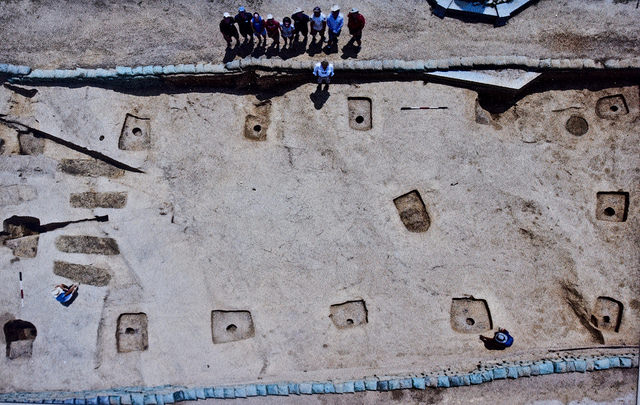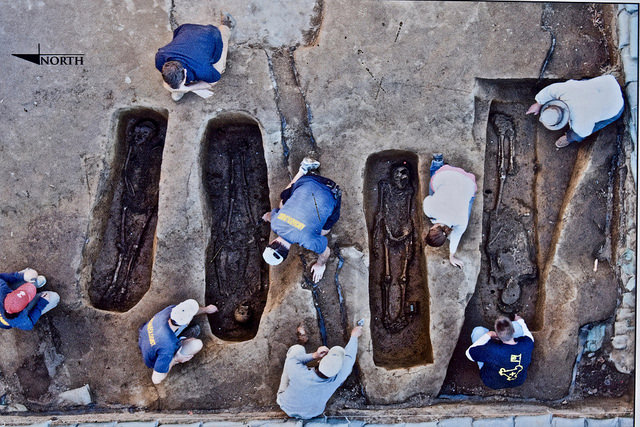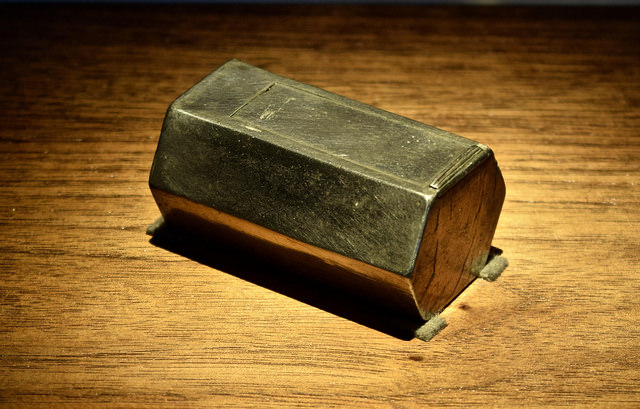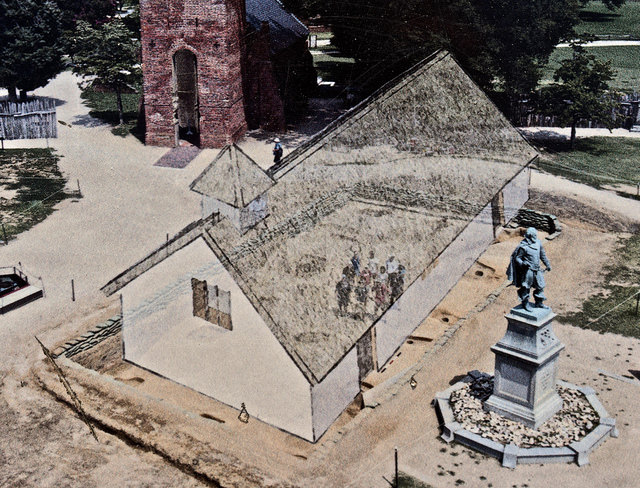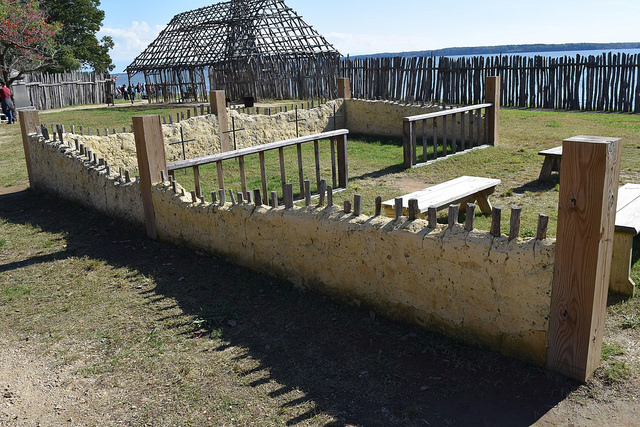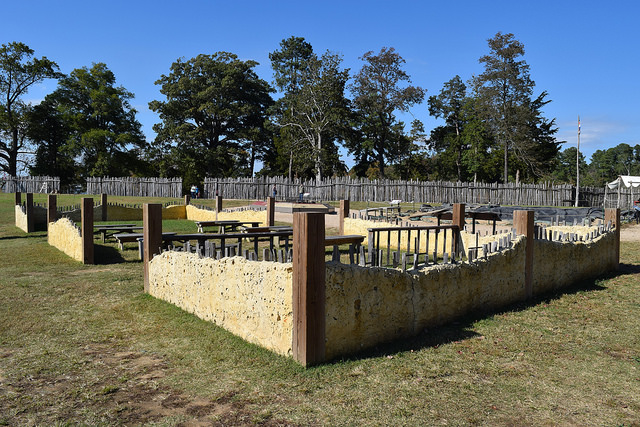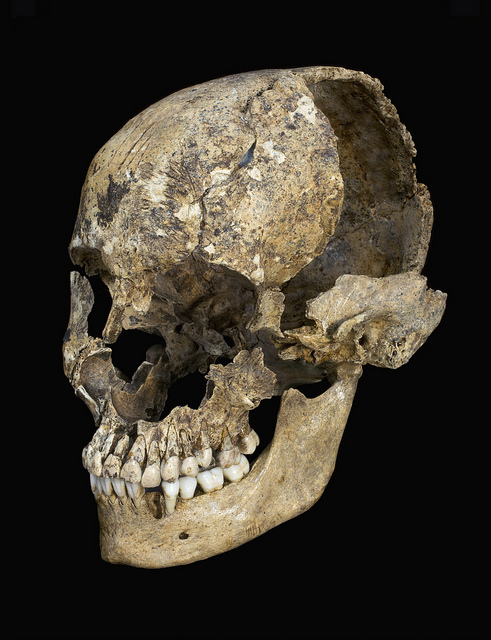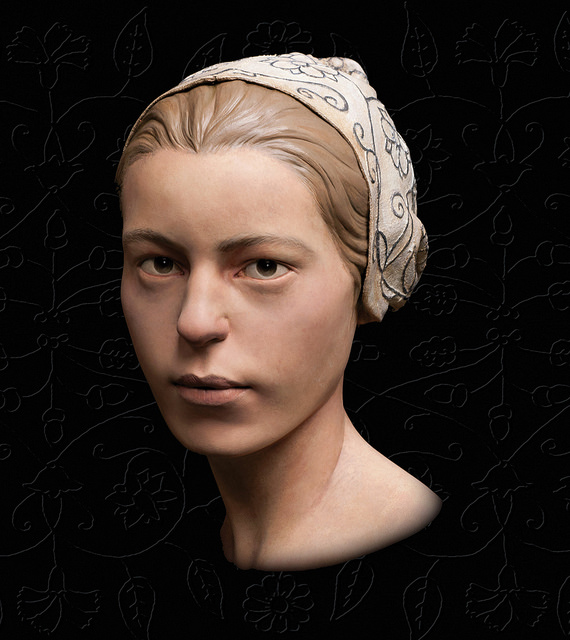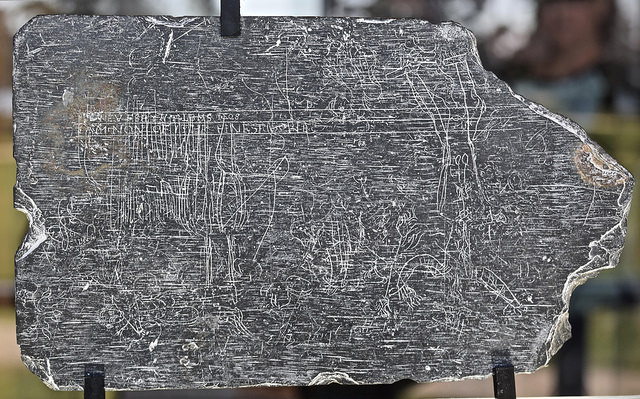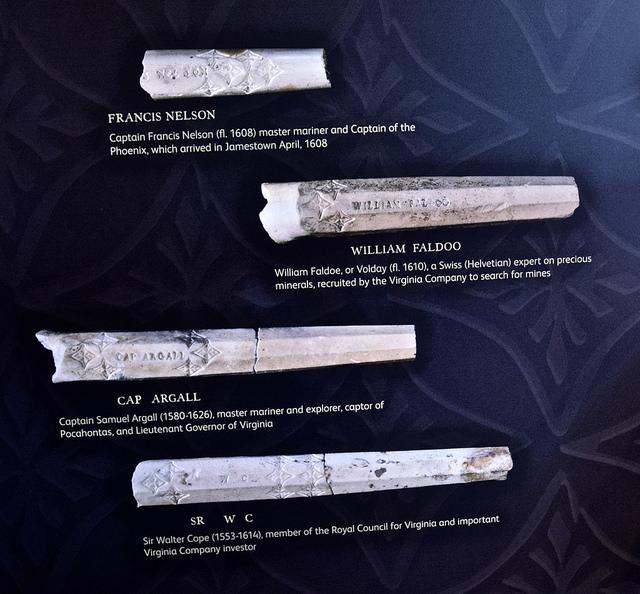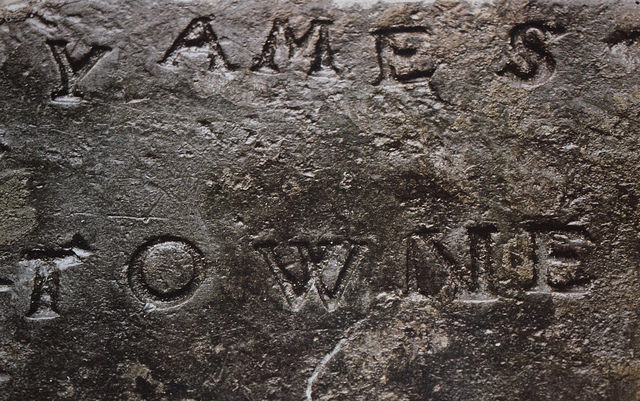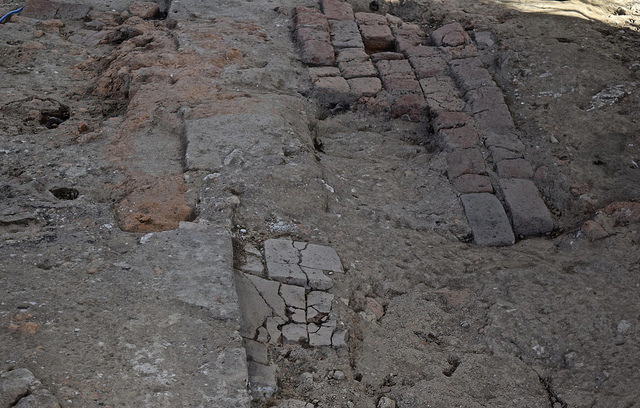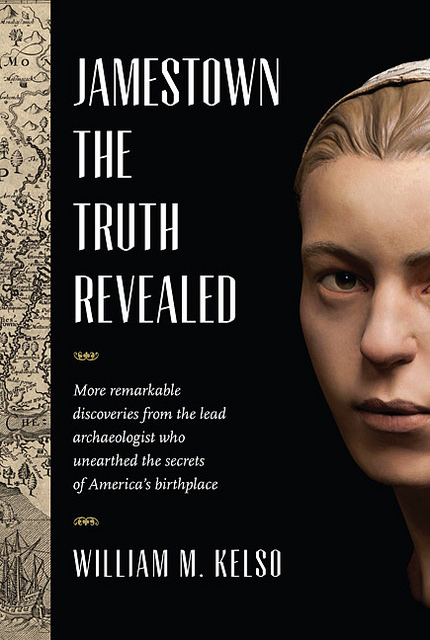
It was an instance of serendipity when, one day in late October, 2017, I happened to cross paths with William Kelso. We had no plans to meet, but I recognized him as I was snapping some photos of the most recent excavations within the vicinity of the old Memorial Church at the Jamestown Island, Virginia, archaeological site. Kelso is best known for his pioneering work discovering and uncovering the remains of the long-lost James Fort, thought for decades, until 1994, to have vanished into the water of the James River long ago as the river eroded its way into the island over the centuries. That discovery, and the hundreds of thousands of artifacts that have since come to light about America’s first permanent English colony, have arguably for many defined one of the great archaeological discovery stories of the past century.
We spoke only briefly, but it was enough to generate the distinct impression that Kelso, currently Head Archaeologist for the Jamestown Rediscovery Project and veteran of decades of research, had no plans to retire soon. His legacy, however, has already been made. Standing to witness were the manifestations of evidence for America’s first permanent English colony surrounding us as we talked, from sections of the reconstructed post-in-ground palisade walls of the original 1607 James Fort to the partial reconstruction overlying the footprint of the first-ever church structure built at the site, where Pocahontas and John Rolfe exchanged their marriage vows in 1614. This is aside from the more than two million total artifact haul accumulated since Kelso’s excavations at the site began, most of which is unseen by the public eye but some of which, over 4,000 strong, can be seen in the Archaerium museum only steps away from where we stood to talk.
For most people it would be enough to walk about the site. It is certainly impressive enough. But for other members of the public, like me, curiosity can only be sufficiently quenched by thoroughly reading about the details of the groundbreaking (pun intended) discoveries that have been made here over the past 20+ years. Kelso has made this possible with the publication of his most recent book, Jamestown,The Truth Revealed.
Kelso qualifies by making no secret of the fact that fully 60 percent of the book constitutes a re-publication of his previous book, The Buried Truth, to provide a fuller context or precursor to the discoveries made in more recent years, equally compellingly documented in the book’s second part, “More Buried Truth”.
It is the book’s second part, and more, that is the focus here. I relate it by way of the chapter headings assigned within the book itself:
Holy Ground
As the title of Part II’s first chapter suggests, excavation work at the site has uncovered some tantalizing evidence of the central role the English, or Anglican, Church played in the culture of Jamestown’s first colonists. Wasting little time after their arrival in 1607, the colonists, under the direction of its leadership, constructed one of America’s first English ecclesiastical buildings — a simple post-in-ground structure that saw several renovations or revisions in very short order. William Strachey, writer and Secretary of the Colony in 1610, wrote this first-hand account of the structure, in which Pocahontas and John Rolfe were famously married in 1614. It describes the church as it appeared during his tenure:
In the middest [of the fort]…is a pretty chapel…It is in length threescore foot, in breadth twenty-four…a chancel in it of cedar and a communion table of black walnut, and all the pews of cedar, with fair broad windows to shut and open…and the same wood, a pulpit of the same, with a front hewn hollow, like a canoe, with two bells at the west end. (1)
It was Strachey’s account of the structure, clues from other sources, and excavations in the southeastern sector of the James Fort that turned up the tell-tale signs of the building, revealing deep post-holes all in alignment very close to the dimensions Strachey described, and four burials located in what would be the chancel area of the church.
Although the traces of the church structure was big news when archaeologists first revealed the remaining soil stains left by the structure’s long-decayed post architecture, it was the burial discoveries that eventually commanded the most attention from the press and public. That is because, consistent with the long-held burial practice of English society at that time, high-status individuals were found to be buried beneath church chancels — and, in this case, it would be individuals who had played essential leadership roles in the founding and settlement development of Jamestown in its very earliest years. Forensic analysis of the skeletal remains, other archaeological evidence, chemical analysis, and historical documents confirmed with a confident degree of certainty that the individuals buried within the chancel space were likely Reverend Robert Hunt, Sir Ferdinando Wenman, Captain Gabriel Archer, and Captain William West, all known “movers and shakers” of the Jamestown settlement. Kelso, without getting the reader lost in what could have been a mind-numbing technical report, nonetheless goes into meticulous and satisfying detail about the discoveries in the text of the chapter.
Identifying the big names was sensational, without question. But how did the early church finds add to what we already knew about the first years of the Jamestown settlement?
Kelso emphasizes at least several major takeaways. First, that “the biographies of four practically anonymous Jamestown leaders have come to life,” and that “Wenman and West, both relatives of De La Warre [the Jamestown leader best known for having commanded the supply fleet that arrived in Jamestown in June 1610 after the ‘starving time’, in time to save the colony from a final collapse], were held in high esteem at Jamestown.” Second, it suggested how the established system of English hierarchy was transported to the New World, with the Anglican Church as the “center of the James Fort’s society, spiritual and secular.” And third, the excavation results confirmed that the first, 1608 – 1616 church structure stood apart and separate, although only yards away, from the later church built upon a brick-on-cobble foundation, the one initially built in 1617 and in which America’s first democratic assembly met in 1619. The church where Pocahontas was married was not the same church in which the seeds of the U.S. American government were planted. (2)
_______________________________________
Aerial view of the excavated features of the 1608 church. Photographed detail of an informational placard at the Jamestown historic site. Jamestown Rediscovery project, Preservation Virginia
______________________________________________________
Excavated burials in the 1608 church chancel area. Photographed detail of an informational placard at the Jamestown historic site. Jamestown Rediscovery project, Preservation Virginia
____________________________________________________
Above: Archaeologists unearthed a small silver box, placed at the time of his burial on top of Gabriel Archer’s coffin. Micro CT scanning analysis revealed it to be a reliquary, which is a container for holy relics. Although corrosion has precluded analysts from opening the box, scanning revealed that it contained fragments of bone, likely human, and fragments of a lead ampulla. Ampullae were small flasks used to carry blood, holy water, or oil. Why it was placed on Gabriel Archer’s coffin remains a mystery.
____________________________________________________
Artist’s illustration depicting the form and dimensions of the 1608 church as it would have appeared in its day. Photographed detail of an informational placard at the Jamestown historic site. Jamestown Rediscovery project, Preservation Virginia
_______________________________________
Above and below: Views of the partially reconstructed 1608 church, after excavations.
____________________________________________________
_____________________________________
Jane
Although Jamestown’s claim to fame has rested primarily on its mantle as America’s first successful English colony, a darker side to its story tells how close the fledgling colony came to failure. That close call, as most people who have followed the Jamestown story know, was due most acutely to the horrendous period of starvation the colonists faced during the winter of 1609 – 1610. Brought on by a combination of concurrent factors, such as crumbling relations with the local Powhatan resulting in hostility and siege of James Fort, a drought, and dwindling food supplies and sources, it became known to history as the “starving time”. The written record has recounted this episode with some startling narrative:
Wee cannot for this our scarsitie blame our Comanders here, in respect that our sustenance was to come from England…soe lamentable was our scarsitie that we were constrayned to eat Doggs, Catts, rats, Snakes, Toadstooles, horse hides and wt nott, one man out of the mystery that he endured, killinge his wiefe powdered her app to eate her, for wch he was burned. Many besides fedd on the Corps of dead men…and one who had gotten unsatiable, out of custome to that foode could not be restrayned, untill such tyme as he was executed for it.(3)
The historical narrative is powerful and excruciatingly detailed, but generations of scholars and the public had to rely on the truthfulness and accuracy of the written word for these events — the physical evidence was absent. Until, that is, Kelso and his team began uncovering artifacts and bones that indicated something terrible was happening at Jamestown during this period. Excavations yielded burials, bones, artifacts and contexts that, after analysis, provided plausible evidence that the “starving time” did indeed occur and was likely as horrific and severe as documented. The one discovery that captured the imagination of scholars and the public alike, however, was the recovery of the remains of a 14-year old girl. Kelso relates the details of this story in the chapter, Jane. Reading almost like a detective mystery, Kelso does not scrimp on the thorough telling of how the researchers, through archaeological and forensic anthropological analysis, determined that the skeletal remains, consisting of more than a dozen specimens including a female human skull, jaw with teeth, and shin bone — all found with discarded “starving time” trash in a cellar/kitchen fill — had been butchered in an act of cannibalism. Doug Owsley, the Smithsonian Institution’s renowned forensic anthropologist and a consultant to the Jamestown excavations, was key to making the determination:
Owsley determined that the skull and leg bone had undergone sustained blows, chops, and cuts from several sharp, metal implements, reflecting a concerted effort to separate the brain and soft tissue from bone. Months of intensive scientific testing — including high-magnification technology, stable isotopic tests for oxygen, carbon, and nitrogen, and tests for lead — determined that the bones were the remains of a fourteen-year-old English girl of lower status, probably raised in southern England. Owsley concluded that the rigorous postmortem cuts to the skull and jaw, and the way the leg was severed, were clear evidence of cannibalism.(4)
Researchers have been unable to pinpoint the girl among the roster of settlers, and thus she remains unidentified. She is known simply by the name, for lack of any other, assigned to her: “Jane”.
Researchers have since created a believably lifelike and, by professional standards, accurate forensic sculptural reconstruction of Jane’s face and skull using a digital resin copy of her skull based on the skeletal finds. In addition to reading about the Jane story in Kelso’s book, it is well worth the visit to the Archaerium museum at the Jamestown site to view the reconstruction.
___________________________________
The cannibalized remains of Jane, all constituting parts of the (1) skull; (2) shin bone; and (3) jaw. Photographed from a public display illustration in the Archaerium.
______________________________________________
Jane’s skull. Smithsonian image
_________________________________
Forensic sculpture reconstruction of Jane’s face. Studio EIS
____________________________________
Company Town
Archaeologists get very excited about finding middens (old refuse dumps) and wells. There is good reason for that. Like treasure chests for archaeologists, they often contain the greatest concentration of the bits and pieces of past civilizations. This has been particularly true for Jamestown. In the book’s final chapter Kelso covers a lot of ground, but his discussion of what Jamestown excavators have recovered from the historic James Fort wells dominates the narrative. And rightly so. The wells, particularly the two described in “Company Town”, have yielded some of Jamestown’s most intriguing artifacts. Although thousands of artifacts were recovered, one of the wells, associated with an excavated storehouse and its cellar, constructed inside the James Fort palisade triangle, gave up two objects worth noting here: A 5” by 8” slate tablet featuring inscriptions of words, symbols, numbers, and drawings of people, animals and plants; and fragments of 8 curiously marked Robert Cotton* clay tobacco pipes. The slate tablet discovery, which Kelso described as “not unlike finding the proverbial lost letters in an attic trunk,” had the distinction of being “both an archaeological find and a historical document.”(5) But accurately reading and interpreting the inscriptions on its face have been challenging, to say the least. Nonetheless, Kelso devotes fully 8 pages to describing the inscriptions, the efforts to understand them, and what they mean in terms of understanding what was happening at Jamestown. A close second in terms of the chapter content is the 7-page description of the pipe finds. These pipe fragments were interpreted to bear the names of 8 well-known English gentlemen: Sir Walter Raleigh, Lord De La Warre, Captain Samuel Argall, Sir Charles Howard, Henry Wriothesley, (the Earl of Southampton), Captain Francis Nelson, Sir Walter Cope, and Robert Cecil (Lord Salisbury) — all gentlemen associated with the Jamestown venture in different ways. “Why Cotton had to name them remains one of the most intriguing mysteries of the abandoned cellar/well finds,” Kelso writes. “Like the writing slate, however, the names on the pipes are examples of some of the surprisingly literal messages left to us by Jamestown’s past.”(6)
The second of the two wells, described by Strachey as intended to replace the old storehouse/cellar well, was discovered about 80 feet further north of the old well, but still within the James Fort palisade triangle. Its story is as much about its original construction as the artifacts found within. As the archaeologists excavated, they discovered that “at a depth of eight feet, six inches, the soil became moist, and remnants of timber lining appeared. Digging below that revealed more and more intact remnants of the lining until the timber was completely preserved to the bottom, fourteen feet below grade.”(7) The latter part of the excavation had to be conducted in water — a difficult situation — but in addition to the timber, the conditions produced by the water in the bottom portion of the well helped to preserve some other tantalizing finds, such as the remains of a child’s leather shoe and what is thought to have been Lord De La Warre’s ceremonial halberd, intact and remarkably preserved. An elegant loaded pistol, of a type that was likely considered state-of-the-art for its day (apparently finding its way into the well between 1610 and 1617), was also found, as well as a lead “Yames Towne” shipping tag.
_______________________________________
The slate tablet, as exhibited in the Archaerium
______________________________________
A selecion of the pipe stems, as exhibited in the Archaerium
___________________________________
Detail of a lead Jamestown shipping tag, dated to 1611, found in the timber-lined well. As exhibited in the Archaerium
________________________________________
Holy Ground, Again
The book notwithstanding, it does not tell the end of the Jamestown excavations story. Indeed, the ink had barely dried with the book’s publication as excavations progressed full swing within the 1906 Memorial Church, today the most prominent architectural feature at the James Fort site. One of the excavation’s objectives, as with the first post-in-ground church dig to its northeast, is to uncover and hopefully identify who was buried in the church chancel — likely, as English tradition held in the early 17th century, burial remains of some of Jamestown’s most notable citizens.
Could the burials include Lord De La Warre, otherwise known as Thomas West, the leader who rescued the Jamestown colony from collapse with new supplies after the starving time, John Rolfe, the first successful tobacco planter and husband of Pocahontas, and George Yeardley, one of colonial Virginia’s early governors?
Intriguing new evidence unearthed within the chancel area of the church might possibly provide some clues. Archaeologists have already revealed evidence of burials, the presence of which were known from previous excavations conducted soon after the turn of the 20th century. Examination of recovered bones from the recent excavations by Smithsonian scientists in the lab are beginning to yield new information about who the bones represent, but nothing yet definitive in terms of identifying the buried. One set of bones, however, exhibited signs that the individual was robust, a man in his forties, and had tell-tale signs of having been a horseman. At least two out of the three findings thus far are consistent with what is known about Lord De La Warre.
It will take some time to ferret out the findings at the site and in the lab. For one thing, previous excavations and disturbances have vastly complicated the process. “We have not uncovered any more bones in place as of yet,” Kelso told Popular Archaeology. “We are still trying to sort out which graves came before which graves by the disturbed soil above the actual buried skeletal remains.”
One additional recent discovery is worth noting — a small metal box containing what has been detected by x-ray examination to be a piece of folded paper was unearthed in the northeast corner of the church foundation. A written note? “The paper is unreadable so far and probably never will be,” said Kelso. “Of course there is no doubt that the tin container was purposely buried [by the early excavators] under the north corner of the 1640s church during the 1901 digging.” The find exemplifies the many limitations and mysteries that may always remain about historic Jamestown, even through to the 20th century.
One thing should be emphasized — there is much more to the Memorial Church excavations than unearthing burials, (all of which, once recovered and researched, will be re-buried in accordance with the requirements of the Virginia Department of Historic Resources). The current structure, after all, lies above the foundation of the original 1617 structure, the church in which the first English governing representative assembly in America met. It was, among other things, the birthplace of the kind of government that eventually became the United States as we know it today and the center of the religious culture that helped to define a nation. Archaeologists are, at this writing, exploring the old foundations and recovering artifacts that will help to develop a deeper understanding of that historic site and its place in the American heritage.
_______________________________________
Excavation in progress within the Memorial Church
____________________________________________________
Interested readers may obtain a copy of Kelso’s latest book, Jamestown, The Truth Revealed, by going to the University of Virginia Press website. The book is, in this writer’s opinion, a must-read for those who want an in-depth, engaging, and easily understood source for the story of how archaeology is both affirming and revealing important beginnings of the American experience.
_____________________________________________________
Notes:
- Strachey, in Wright, Voyage to Virginia, 80.
- Kelso, William M., Jamestown: The Truth Revealed, 2017 University of Virginia Press, pp. 182 – 184.
- A True Declaration of the estate of the Colonie in Virginia, 1610, and The Tragical Relation of the Virginia Assembly, 1624, in Tracts and Other Papers, ed. Peter Force, 4 vols. (Washington, D.C., 1836 – 46), 3:16.
- Kelso, William M., Jamestown: The Truth Revealed, 2017 University of Virginia Press, p. 189.
- Kelso, William M., Jamestown: The Truth Revealed, 2017 University of Virginia Press, pp. 210 – 211.
- Kelso, William M., Jamestown: The Truth Revealed, 2017 University of Virginia Press, p. 226.
- Kelso, William M., Jamestown: The Truth Revealed, 2017 University of Virginia Press, p. 228.
*Robert Cotton was a pipe-maker sent to Jamestown as part of a re-supply in 1608, and is responsible for the making of a number of pipes found at the Jamestown excavations.
____________________________________________________
Become a Popular Archaeology premium subscriber.
___________________________________________
Travel and learn with Far Horizons.
____________________________________________

